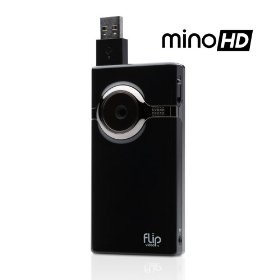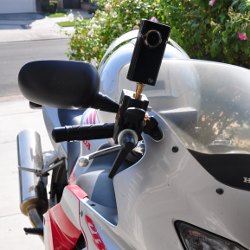 I really like the Flip video cameras. I reviewed the original Flip Mino back in June and recommended it for anyone who wanted to shoot more than a couple of minutes of video at a time or who wanted to reserve the space on their camera’s memory card just for pictures. The Flip Mino is a handy, compact, easy to use video recorder. And the Flip Mino HD (Amazon) is virtually identical in every way except one—it records 720p HD video.
I really like the Flip video cameras. I reviewed the original Flip Mino back in June and recommended it for anyone who wanted to shoot more than a couple of minutes of video at a time or who wanted to reserve the space on their camera’s memory card just for pictures. The Flip Mino is a handy, compact, easy to use video recorder. And the Flip Mino HD (Amazon) is virtually identical in every way except one—it records 720p HD video.
Everything I liked about the Flip Mino I like about the Flip Mino HD. The body and controls are identical. You can’t even tell them apart visually except for the “HD” logo on the back. They operate exactly the same and feel exactly the same in my hand. Everything I wrote in my earlier review about the Flip Mino applies to the HD version. So let’s get on to video quality.
The video and sound quality are quite good. Video is recorded in H.264 format at 30 frames per second. Audio is recorded in AAC format at 44.1 kHz. The average bitrate is about 9 Mbps which lets the Flip store about 60 minutes of video on its internal 4 GB memory. Previous Flip models recorded MPEG4 AVI files. The Flip HD records H.264 MP4 files.
Like the previous models, although the video quality and sound are good, it’s hampered by a cheap fixed-focus lens. Images aren’t incredibly sharp or vivid, but honestly, I think it does what anyone should expect from such a low-cost device. Video from this camera is easy to watch full-screen on a 21″ LCD monitor or TV. But really, like previous models, the videos from this camera are designed to be uploaded to YouTube or other video sharing sites.
One problem I noticed with the Flip was a weird visual artifact caused by shaking of the camera itself. You can see it clearly in the second video below in tall vertical lines like the street lamps and trees. When the camera shakes quickly they go all wobbly. I think this is an artifact of the underlying hardware and how the data is read off the sensor. There’s probably a name for it but I don’t know what it is or exactly what causes it. Any AV experts out there please weigh in in the comments. It should be noted that under normal circumstances this effect isn’t a problem at all.

Having just bought a Nikon D90 I wanted to compare the video quality between the two cameras. They both record 1280×720 video. I give the edge in video quality to the D90 because it gives you much more creative control over the video and the lens is always going to be better. Beyond that, the D90 is a big black camera and the Flip is, well, a tiny black camera. The D90 can only record HD video in 5 minute clips. The Flip can record for up to 60 minutes all at once. The D90 uses removable storage media but with the Flip you’re stuck with its 60 minute internal memory. The Flip has a fixed lens and the D90 is a digital SLR with interchangeable lenses. The Flip HD is a little over $200. The D90 kit is over $1,100.
So which is better? As you can see, they are really completely different animals. The Flip is a dedicated video machine that can record high quality video for long periods of time. It’s a nice companion to any still camera, even to the D90 which can shoot video itself. I found that it’s ease of use was perfect for situations where I didn’t really care about getting “creative” and just wanted to record something quickly and easily. And when you’ve got to record something between 5 and 60 minutes, it wins hands down.
 The Flip HD is a nice camera. If you have an original Flip but you want higher resolution video, this is a worthy upgrade. For those looking for a new digital video recorder, start here.
The Flip HD is a nice camera. If you have an original Flip but you want higher resolution video, this is a worthy upgrade. For those looking for a new digital video recorder, start here.
Sample Video
Below I’ve got two full-resolution sample videos. I shot the first indoors under fluorescent lighting in a typical usage scenario. The second is slightly less typical… I clamped the Flip to the bars of my scooter and went for a totally legal ride (in which no traffic or safety laws were broken for the entire 40 second clip).
Click the link beneath each one to download the original MP4 file (warning: they’re big). Don’t judge the video quality based on the re-encoded flash video below. The originals are much nicer and smoother. Download the full-resolution original videos to get a real measure of their quality (courtesy of blip.tv).
Click to download sample 1 original (1280×720)
Click to download sample 2 original (1280×720)









The visual effect that happens when the camera is moved is often referred to as “rolling shutter effect” or “jello effect” and happens in low end sensors because data is read line by line instead of all at once.
Does the flip mino hd take still pictures?
No, it’s video only.
Since the lithium battery is non-replaceable, do you have to throw the Flip Video Mino HD out once the battery is completely dead (like I did with my first IPOD??)
I don’t know. In theory, yes. Like iPods though, there may be an aftermarket for battery replacement or even sending old units in to the company for refurbishment (like Apple does).
So overall, is getting the HD worth the extra $80 investment, if all yo plan on doing is shooting simple 5 minute, fairly static videos? Thanks!
Think of it like this… when I was a kid my parents showed me old black and white film home movies on a reel to reel projector (yah, I’m that old). Small, grainy picture, no sound. One day, you’re digital home movies that seem so awesome now are going to feel like that. I’d go with the HD.
Also, if you want the non-HD version, get one soon. I doubt you’ll be able to buy a non-HD camera in the near future.
The rolling shutter (jello) effect looks quite noticeable on all of the clips, where the sensor seems to be reading line by line as the image, coming through the lens, is still changing.
The result seems to be the whole image looks wobbly with horizontal bands contracting and expanding as the camera moves up and down. I guess these cameras work better on a tripod.
It shows promise, but for me, the fact it’s HD is a bit academic when the image is so wobbly. If it’s because they are using a cheaper sensor, then they really need to go for something that captures frames instantly, not scanning them line by line while the subject matter is moving.
The Kodak Zi6’s image is similarly wobbly.
I think you’ll find this problem on most video cameras built on CMOS sensors. From what I’ve read, it’s the simplest way to get video from that technology.
I downloaded both clips and found the images out of sync from the sound, and a bit bouncy-looking. I need this tool to record seminar-like presentations for work, to post on the web. I could use a tripod. Should I worry about this “out of sync” presentation? I think it would be distracting to viewers needing to understand content.
Also – does it fit regular camera tripods?
The video shouldn’t be out of sync with the audio. It’s not for me on my computers including a Mac laptop and a Linux desktop. Playing back HD resolution video smoothly can be a difficult task depending on your computer. Newer, faster computers do it better, of course, but it also depends on your video card, memory, other software installed, etc.
It fits regular tripods.
Any idea on how long you can record at one time? I was trying to do a time lapse and set the flip HD on a tripod and let it sit. Battery was fully charged. When I came back about an hour later – it only got 16 min of video.
I didn’t do a battery test on the Flip HD but the manufacturer says it should last 2 hours.
I received one for Christmas as a gift and straight out of the box there were dead pixels on the CMOS sensor. After days of tedious email exchanges with Pure Digital they gave me an RMA number. They held onto the camera for weeks until I received a response to numerous emails regarding the status or my repair/replacement. They sent me a new factory-fresh camera that was more problematic than the first. Althought the image is clean, files do not encode properly (sections of green frames /stuttering) On my vacation to Utah 75 percent of my footage was encoded improperly, unplayable or were just suddenly erased and the file structure reset: i.e. Clip VID00021.MP4, VID00022.MP4 clips all dissaper then start recording at VID00001.MP4 again.
I really wanted to love this camera and I don’t expect a whole lot of a two hundred dollar but this turd can’t even perfom it’s basic purpose of recording images and saving them until I can dump them to my computer.
On top of that, Pure Digital’s customer support has the lazy reponse time you would expect from a government agency, not a supposedly hungry Bay-Area Tech company looking to take on established camera companies. Truly dissapointing.
At the moment I’d chose the Casio Exilim EX-300 over the Mino HD. About the same ergonomics and price, but no rolling shutter.
The Casio EX-Z270/400 and also do 720p, but use MJPEG instead of H.264. That means bigger files.